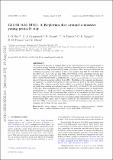Files in this item
G11.92-0.61 MM1 : a Keplerian disc around a massive young proto-O star
Item metadata
| dc.contributor.author | Ilee, J. D. | |
| dc.contributor.author | Cyganowski, C. J. | |
| dc.contributor.author | Nazari, P. | |
| dc.contributor.author | Hunter, T. R. | |
| dc.contributor.author | Brogan, C. L. | |
| dc.contributor.author | Forgan, D. H. | |
| dc.contributor.author | Zhang, Q. | |
| dc.date.accessioned | 2016-10-11T11:30:22Z | |
| dc.date.available | 2016-10-11T11:30:22Z | |
| dc.date.issued | 2016-11-11 | |
| dc.identifier | 246547269 | |
| dc.identifier | 580b1f60-90bb-4c39-924d-2bc0e7386232 | |
| dc.identifier | 84994519171 | |
| dc.identifier | 000385231600066 | |
| dc.identifier.citation | Ilee , J D , Cyganowski , C J , Nazari , P , Hunter , T R , Brogan , C L , Forgan , D H & Zhang , Q 2016 , ' G11.92-0.61 MM1 : a Keplerian disc around a massive young proto-O star ' , Monthly Notices of the Royal Astronomical Society , vol. 462 , no. 4 , pp. 4386-4401 . https://doi.org/10.1093/mnras/stw1912 | en |
| dc.identifier.issn | 1365-2966 | |
| dc.identifier.other | ArXiv: http://arxiv.org/abs/1608.05561v1 | |
| dc.identifier.uri | https://hdl.handle.net/10023/9643 | |
| dc.description | JDI gratefully acknowledges support from the DISCSIM project, grant agreement 341137, funded by the European Research Council under ERC-2013-ADG. CJC acknowledges support from STFC grant ST/M001296/1. PN, CJC and JDI gratefully acknowledge support in the form of an Undergraduate Research Bursary from the Royal Astronomical Society. DF acknowledges support from the ECOGAL project, grant agreement 291227, funded by the European Research Council under ERC-2011-ADG. | en |
| dc.description.abstract | The formation process of massive stars is not well understood, and advancement in our understanding benefits from high-resolution observations and modelling of the gas and dust surrounding individual high-mass (proto)stars. Here, we report subarcsecond (≲1550 au) resolution observations of the young massive star G11.92−0.61 MM1 with the Submillimeter Array (SMA) and Very Large Array (VLA). Our 1.3 mm SMA observations reveal consistent velocity gradients in compact molecular line emission from species such as CH3CN, CH3OH, OCS, HNCO, H2CO, DCN and CH3CH2CN, oriented perpendicular to the previously reported bipolar molecular outflow from MM1. Modelling of the compact gas kinematics suggests a structure undergoing rotation around the peak of the dust continuum emission. The rotational profile can be well fitted by a model of a Keplerian disc, including infall, surrounding an enclosed mass of ∼30–60 M⊙, of which 2–3 M⊙ is attributed to the disc. From modelling the CH3CN emission, we determine that two temperature components, of ∼150 K and 230 K, are required to adequately reproduce the spectra. Our 0.9 and 3.0 cm VLA continuum data exhibit an excess above the level expected from dust emission; the full centimetre–submillimetre wavelength spectral energy distribution of MM1 is well reproduced by a model including dust emission, an unresolved hypercompact H II region, and a compact ionized jet. In combination, our results suggest that MM1 is an example of a massive proto-O star forming via disc accretion, in a similar way to that of lower mass stars. | |
| dc.format.extent | 2317643 | |
| dc.language.iso | eng | |
| dc.relation.ispartof | Monthly Notices of the Royal Astronomical Society | en |
| dc.subject | Stars: individual: G11.92-0.61 | en |
| dc.subject | Stars: massive | en |
| dc.subject | Stars: pre-main sequence | en |
| dc.subject | Stars: protostars | en |
| dc.subject | Radio continuum: stars | en |
| dc.subject | Submillimetre: stars | en |
| dc.subject | QB Astronomy | en |
| dc.subject | QC Physics | en |
| dc.subject | NDAS | en |
| dc.subject | BDC | en |
| dc.subject.lcc | QB | en |
| dc.subject.lcc | QC | en |
| dc.title | G11.92-0.61 MM1 : a Keplerian disc around a massive young proto-O star | en |
| dc.type | Journal article | en |
| dc.contributor.sponsor | Science & Technology Facilities Council | en |
| dc.contributor.sponsor | European Research Council | en |
| dc.contributor.institution | University of St Andrews. School of Physics and Astronomy | en |
| dc.contributor.institution | University of St Andrews. St Andrews Centre for Exoplanet Science | en |
| dc.identifier.doi | 10.1093/mnras/stw1912 | |
| dc.description.status | Peer reviewed | en |
| dc.identifier.grantnumber | ST/M001296/1 | en |
| dc.identifier.grantnumber | en |
This item appears in the following Collection(s)
Items in the St Andrews Research Repository are protected by copyright, with all rights reserved, unless otherwise indicated.

